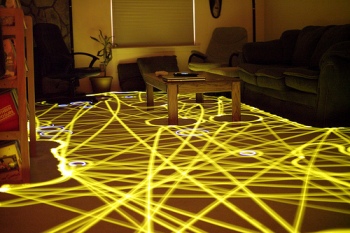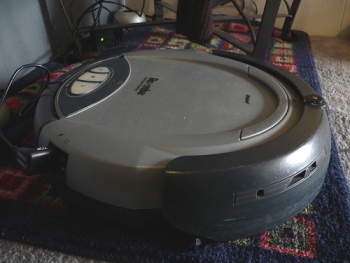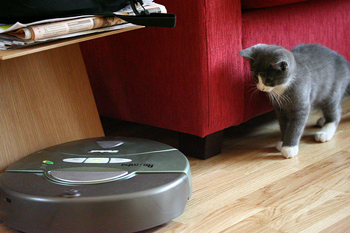iRobot Roomba
Although more and more robotic vacuum cleaner brands join the market, Roomba made by iRobot is still the most renowned and successful of all of them. At least in the West. First roombas were released in 2002. Since then four generations have been introduced with a few differing models in each of them.
Please note!
In this article I‘ve given an overview of the entire iRobot vacuum cleaner product line including information about all previous generations. This way you can see how the vacuum cleaner got to where it is know – which features got introduced when, etc. If however you already know all this and you only want to find out what‘s new about the lastest generation – you can find that info at the bottom of this page.
I‘ve heard that when creating first prototypes the developers partly drew inspiration from insects and the way they do things. Insects don‘t make 5-year plans, they don‘t create sophisticated building plans for their hives. Yet they manage to do remarkable things acting almost purely on instinct.
From this point of view iRobot Roomba exhibits insect-like behavior. It doesn‘t map its surroundings and it basically has ‘no idea‘ where it‘s heading. Yet it has instincts. If it will find a wall it will follow it. If it will find a ledge it will avoid it. Otherwise it just cleans in a pattern that ensures the best coverage based on room size.

I sometimes hear people who are discontented with this. They hold a view that a robot has to know exactly where it‘s going and what it‘s going to do in order to successfully clean a room. I don‘t hold this view. In my opinion Roomba‘s algorithms are complicated enough and behaviors sophisticated enough for it to do it‘s job good enough.
Usually two generation models are officially sold from iRobot Store simultaneously. However, older models usually can still be found on different sites such as Amazon, Ebay and others some time after they‘ve been discontinued. As parts and accessories can still be bought from iRobot Store older models may be a viable option if you‘re willing to spend less.
First Generation

The first generation roomba was an achievement in itself. You have to remember that ten years ago robotic vacuum cleaners weren‘t a commonplace thing. That‘s assuming that they are now.
The Roomba wasn‘t the first commercially available robot vacuum cleaner. Electrolux Trilobite was. The Trilobite could navigate the room using ultrasound and did a pretty good job. The only major flaw was its price. It cost nearly two thousand USD.
At this point a robotic vacuum cleaner that worked well and cost two hundred as opposed to two thousand was a revolution. In essence, releasing the Roomba iRobot brought robotic vacuuming technology to the masses. It turned out to be a major success as we can witness now.
In case you‘re wondering
virtual walls – devices that emit an IR beam that the robot won‘t cross.
Spot cleaning mode – the robot will diligently clean a 3ft area
MAX cleaning mode – the robot will clean until its battery is depleted
There were three first generation iRobot vacuum cleaners – Roomba, Roomba Pro and Pro Elite. The latter two were released a year later – in 2003. All three models had a 90-day warranty on parts and labor and had such features as – edge cleaning and cliff detection. The battery lasted 1 to 11.5 hours depending on the floor surface. Virtual walls could also be used.
Apart from accessories Pro and Pro Elite models introduced two new cleaning modes that were later found in other iRobot vacuum cleaners – Spot cleaning and MAX. MAX mode was only available in Pro Elite unless you bought Pro Elite‘s remote for your Pro. Pro lacked a button to start MAX mode but it could be started using the remote.
Second generation robots – Discovery series/4xx

Second generation Roomba models were initially known as the Discovery series and later renamed as 4xx. This is why you can find essentially the same robot named differently in different sources. For example – Roomba Red or Roomba 410
Apart from updated design (including a larger dustbin), second generation robots had better software that could calculate the room size and detect particularly dirty spots. Fast charging capability was also introduced as well as home bases, ability to return to them and scheduling. Essentially, not all models had all of these improvements. Still, this is what the second generation introduced to the product line.
So, there were five second generation base models plus ten additional models and editions that were basically one of the five base models with different accessories and/or color. Such as Roomba Silver that was basically Roomba Sage (416) with silver finish.
The most basic of all second generation roomba models was roomba 400, initially called just Roomba. Although there was a similarly named first gen model this is a different robot. The 400 was the most modest one in terms of possibilities and options. It had a one year warranty, no virtual walls included (though it was able to use them), etc. However, it could clean autonomously and not fall down the stairs.
The 410 version and its modifications were a bit more advanced than the 400 version. This robot could detect dirtier places and spend more time cleaning them – so called dirt detect function. It also had the spot cleaning mode and a 1 year warranty.
The 416 version or Roomba Sage had the same features as 410 with a few additions. The most notable one is that this version came with a fast charging capability. It could be fully charged in 3 hours. Both above mentioned robots could be charged in 7 hours. The 416 had the MAX cleaning mode too.
These three models were sold as entry level robot vacuums a few years after third generation models entered the market in 2007. However, next two robots I‘m going to discuss didn‘t stay in the market long after third gen robots were introduced. These were high-end second generation models that had to go after new ones came to replace them.
These were Roomba Discovery and Scheduler (different models ranging from 420 to 434 in 4xx naming system). These models had a different design and all features of previously mentioned models. Apart from these features these models came with more accessories. Also, as the name suggests Roomba Scheduler could be scheduled.
All above mentioned second generation robots can be augmented pretty well. It‘s possible to buy the Scheduler upgrade kit that‘s compatible with all of these robots, the same goes for more virtual walls, a remote and so on.
If you lack a certain cleaning mode in your 4xx robot then buying a remote could be a good bargain. As often a robot lacks a cleaning mode only because there is no button that could start the particular mode. So, if the software is there, the lacking cleaning mode can be initiated using the remote. Because of these reasons second generation models still have a good value for price ratio if you can get one.
There were also a few strange robots in 4xx lineup – 435 – 440. These looked like third generation models yet lacked their features and were sold under second generation names. Either these were some kind of an in between stage, or just stripped down third generation robots. Speaking about third generation…
Third generation – 5xx/610

All 5xx series robots have improved cleaning capacity. Some sources say that even by 100% compared to 4xx series. They all have a 1 year warranty, a dirt detection function, an advanced anti-tangle function, improved edge and corner cleaning and improved floor coverage.
All but 510 are compatible with the self-charging home base. This means that these robots will detect and return to the home base when the battery runs low or when the cleaning is completed.
All versions but pet versions (562 and 532) also have a spot cleaning function. Pet versions are better adapted to cleaning rooms where animals also reside. These have larger sweeper bins, extra brushes and other advantages. Otherwise, pet version robots share similar functions as 560 and 530 accordingly.
The 530 version is compatible with a self-charging home base and it has 2 virtual walls included in the package, whereas 510 is not compatible with a self-charging home base and has 1 virtual wall included. Apart from that, there are not many differences.
The 560 version is more advanced though. It has an on-board scheduling capability which means that you don‘t have to buy something separately to schedule your roomba. It can be wirelessly controlled and it also supports the lighthouse technology.

The lighthouse technology is something like virtual walls with the exception that they can be automatically lifted to allow a roomba to clean the next room. It is a more advanced version of virtual walls if I may say so. It enables a robot to do the work even more autonomously. So, in place of virtual walls 56x robots have virtual lighthouses.
The 570 version shares the same functions as the 560 only it has a wireless command center and extra brushes included. I have heard also about versions 580 and 550, as I understand, all 5xx series above 535 share more or less the same capabilities.
For Your information
Wireless command center – a specific remote that resembles robot‘s user interface. It could be used to steer around the robot, start its cleaning modes, as well as schedule it.
610s were sold as professional vacuuming robots. These robots were intended to be used in high traffic areas like hotels, large houses and similar. It had enhanced brushes and a larger sweeper bin for heavy duty work. Extra brushes were included in the package. Basically, it had the same functions as 570 version with enhancements that enables it to be used in really dirty and high traffic areas plus MAX mode but without the wireless command center.
Fourth generation – 7xx

Fourth generation continues the three digit naming pattern that was introduced when third gen models came out. So, there are three fourth gen models named 760, 770 and 780 accordingly. As always, the cheapest and less feature rich is 760 while 780 is the current flagship of this generation.
This is the latest Roomba generation that has introduced quite a few meaningful design and feature updates. For example – softer bumper material, HEPA filters, updated cleaning head design, updated cleaning algorithm, improved battery management that should improve battery life and a few other features/updates. Let me elaborate on some of these improvements.
As I mentioned, 7xx series iRobot vacuum cleaners have HEPA filters. However, you should note that having HEPA filters is one thing and being full unit HEPA compliant is another thing. HEPA filters don‘t let through particles that are larger than 0.3 microns. On the other hand, full unit HEPA compliance means that the unit itself is designed in a way that prevents dust particles to escape the vacuum cleaner at all.
However, there are no robotic vacuum cleaners on the market that are fully HEPA compliant but there are quite a few of them with HEPA filters. So, the decision to add HEPA filters to the Roomba as well makes perfect sense.
700 series models come with another important design update – the cleaning head has been updated too. The front brush and bearing housings are different. These improvements should ensure better dust picking ability and easier maintenance as new bearing housings should protect bearings from tangling up with hair.
What else? Dirt detect function in 770 and 780 is more powerful than ever. Basically, the difference between dirt detect and dirt detect 2 is additional optical sensors. When combined with the persistent pass cleaning technology (back and forth movements instead of moving in circles when a dirtier spot is found) dirt detect 2 really does improve the outcome.
Another improvement I feel obliged to tell you about is the inclusion of Aerovac 2 bin by default. Now, if you own a 5xx series roomba you probably know that the Aerovac bin for that series‘ cleaners was a huge success. Some users even reported up to 80 % better cleaning capability. The Aerovac bin achieved this by maximizing the airflow, thus it managed to get more debris off brushes.
I can‘t really say that Aerovac 2 is a huge improvement of Aerovac as these bins aren‘t interchangeable and it‘s not possible to use both in the same robot and compare the outcome so you can‘t compare apples to apples in this case. However, as a default bin it definitely is a huge improvement over the standard third series bin.
I‘m not really sure if the last thing I want to mention can really be considered as an improvement. It‘s more like something that‘s just cool – Roomba 780 has a touch interface. I just can‘t help wondering whether Apple will sue iRobot if the latter ever thinks of using multi-touch in the next generation of Roombas.
I hope your head isn‘t spinning right now! So, in a nutshell a quick overview of 7xx series Roombas. All fourth generation roombas have HEPA filters, aerovac 2 bins, updated cleaning heads, remotes included and last but not least all can be scheduled out of the box. 770 and 780 have Dirt Detect 2 and a full bin indicator as opposed to Dirt Detect and no indicator in 760. 780 has a touch interface and it can use virtual lighthouses.
I was actually pretty surprised (not in a pleasant way) when I found out that only 780 will have the ability to use virtual lighthouses. I mean, if most 5xx series robots could use virtual lighthouses and only one 7xx robot can use them now it seems like a pure business decision to me.
That aside, as you can see the growth of iRobot Roomba from its beginnings is quite considerable. Actually, I feel like the fourth generation is the biggest technology leap by far, again setting the bar higher for every other robotic vacuum cleaner on the market. This bar comes with a pretty high price point though. It seems like iRobot is leaving the low end market to other players that have spawned in large numbers lately.
Despite the growing competition in all market segments iRobot still manages to hold the ground and Roomba is still the King. Especially, if we look at robotic vacuum cleaner market shares.
